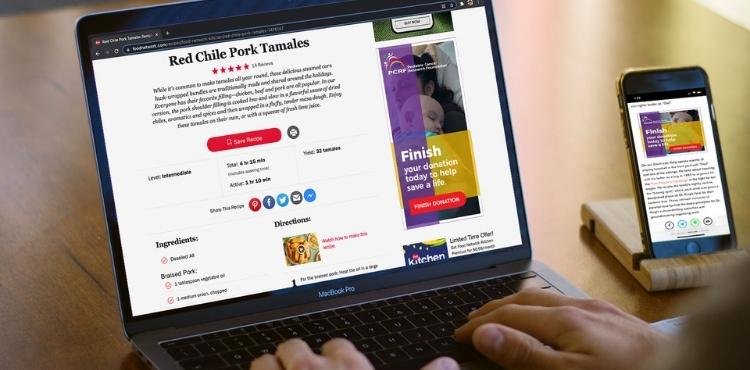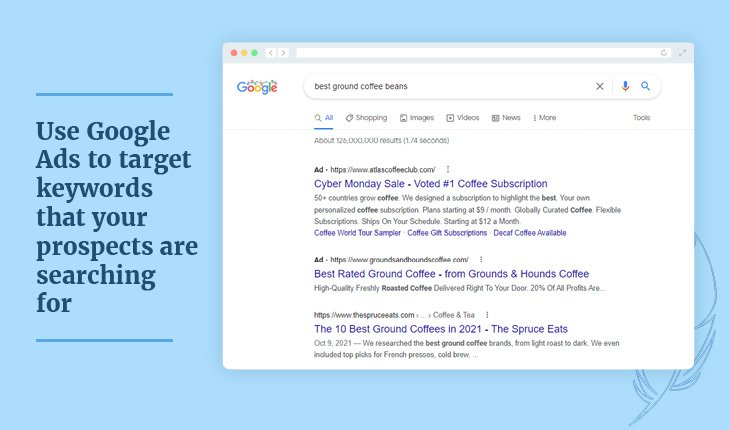
Marketing is an essential part of your nonprofit’s success. As a donation-reliant organization, properly spreading the word about your mission means that more donors will pitch in to lend their support, advocate for your cause, and attract more supporters as your organization gains traction.
As you can see, marketing makes a difference! And it’s changed over time. There were days when marketing consisted only of hanging flyers in local coffee shops and stuffing envelopes to send to every one of your supporters. But our reliance on the internet has brought this print-only era to an end. We still use print media as a part of our marketing strategy, but we lean more heavily on our digital outreach efforts nowadays.
However, one of the digital marketing strategies that nonprofits have yet to take full advantage of is advertising.
We’re still overcoming an age when nonprofits view digital advertising as a solely for-profit strategy. The truth is that this marketing platform is affordable, effective, and accessible for nonprofits as well. Feathr’s digital advertising guide explains that the hesitancy many nonprofits experience toward advertising comes from a limited budget, a reluctance to spend hard-earned money on marketing costs, and a lack of awareness of the organization’s target audience.
In this guide, we’ll combat these hesitancies, discussing ways that nonprofits can use digital advertising to advance their missions and raise more. We’ll cover how digital advertising can help your nonprofit to:
- Decrease abandonment rates.
- Target specific geographic areas.
- Get discovered online.
- Reach new audiences.
Digital advertising can be an incredibly powerful tool for your nonprofit. It will help you get the word out about your organization, raise more money, and increase awareness of your mission. Let’s dive in!
1. Decrease abandonment rates.
There are many ways to employ digital advertising, but one of the best ways to use it is to decrease your form abandonment rates. Have you ever looked at your donation page analytics and realized that many supporters are bouncing from the form?
Donation form abandonment may occur for a variety of reasons. Perhaps the form needs to be optimized to make it more straightforward or decrease the loading time. Maybe your supporters simply got distracted and walked away from the form to fold laundry or do the dishes. Either way, some abandonment happens!
The first step you should take is to optimize your form to make it as successful as possible in raising money on its own by limiting form questions, branding it to your organization, and otherwise optimizing the page. Then, you should redirect those abandoning supporters back to the form when they do leave. You can do this through retargeting advertisements.
Retargeting ads are advertisements that you see in the margins of other websites as you peruse the internet. They redirect you back to a page that you previously viewed.
If you’ve ever viewed a product on Amazon, then saw an advertisement for that product on a site like the New York Times, it’s not a coincidence. That’s how retargeting works! It reminds supporters of the past interest they had and can remind them of their passion for your mission and the donation they never completed.
Here are some tips for your own retargeting advertisements:
- Keep the message in the advertisement short and sweet, making it easily digestible for your audience.
- Brand your advertisement to your nonprofit, leveraging your brand colors, fonts, and logo to visually represent your organization.
- Clearly indicate which page you’re directing your audience to. Clear messages like, “We missed you. Complete your gift, today!” make it apparent that your supporter will return to the donation page.
One reason redirect advertising is so effective is that you have your audience already identified. You’re not posting an ad to be seen by anyone and everyone on the internet. You’re posting one that will be viewed by those who have already expressed an interest in your cause.
To double up on the effectiveness of retargeting advertising, try leveraging it in your email as well. You likely have past supporters’ email addresses. Therefore, use both ads and emails with a message that says, “We miss you!” and direct them back to your mission. This repeated exposure is the most effective way to drive traffic back to your donation pages.
2. Target specific geographic areas.
The days of using flyers in coffee shops to spread the word of your organization to your local community are not quite over. Flyers are still an effective way to communicate with your community. However, they become much more effective when you pair them with digital marketing strategies that will help you reach specific geographic targets as well.
Geofencing advertisements are those that allow your organization to reach an audience in a specific geographic location. It leverages GPS and RFID technology to allow organizations like yours to make sure individuals within a certain geographic range receive the advertisements you’ve created.
Within your community, you may choose to target locations like:
- College campuses. Let’s say your organization is looking for volunteers for a certain event or activity. College campuses can be the perfect place to attract new volunteers as many universities highly encourage community involvement for their students.
- Office locations. If you know where your top prospects work or are looking for corporate partners, office locations can be immensely valuable targets for geofencing advertisements.
- Similar nonprofit venues. If a similar nonprofit organization is hosting an event, you may try to capture their audience as well by setting up advertisements to cover their event area.
Geofencing is the new face of community outreach. You can get in touch with members in your community without ever leaving your office space or home office. It allows you to choose your audience based on the geographic location you know certain people will frequent. College campuses are hubs for college-aged students and office locations are full of employees. You can essentially choose your audience without knowing exactly who they are based on a common feature: location.
3. Get discovered online.
Digital advertising doesn’t only occur in the margins of your favorite websites or on your social media feed. These ads are also featured on a tool that we use almost every day: search engines.
Have you ever noticed that when you search a term on Google, the first several results are usually ads? For example, the following example shows the two ads that populate in the results page of Google when you search the term “best ground coffee beans.”

Paid advertisements are a key part of search engine optimization marketing, allowing organizations to take up space on the first results page on a search engine for particular keywords.
These advertisements allow nonprofits to increase their brand recognition, particularly in relation to keywords that are important to their brand. To take advantage of these advertisements, organizations should take the following steps:
- Conduct research to determine the keywords their audience members are searching for on search engines.
- Determine which pages will be most valuable and relevant for people searching those keywords.
- Register with Google and write the message you want to appear as a part of your advertisement.
These are pay-per-click advertisements, meaning you’ll pay for the number of people who click through these links and visit your page. Essentially, you’re only paying when the advertisement works! Plus, Google actually offers grants that your organization can take advantage of for free advertising on the search engine!
Getting Attention’s complete guide to Google ad grants explains that “if you comply with the program’s rules and guidelines, your organization can continue to receive this $10,000 grant each month for as long as you need.” You simply need to be a registered 501(C)(3) organization, agree to the terms and conditions, have valuable website content, and have a site with an SSL certificate.
4. Reach new audiences.
Supporter retention is vital to the health and success of a nonprofit organization. However, in order to grow, nonprofits need to strike the balance between retaining their existing audience and spreading the word to new audiences. New supporter acquisition can be challenging, but advertisements can help make it a little bit easier.
Specifically, social media advertisements can be essential to your organization’s acquisition strategy. Social sites inherently hold a lot of data about individuals that use their services. These sites have birthdays, employment information, anniversaries, and interests all saved about users.
Through social media advertising, you can leverage the information saved on these sites to make sure your message gets in front of the right audiences to advance your mission.
Social sites like Facebook allow you to leverage this information to narrow down the audience for your organization’s advertisement on the site. You can leverage data to target a specific audience based on their:
- Location
- Age
- Gender
- Demographics
- Behaviors
- Connections
- Languages
- Other
Consider the features and qualities of your current audience. These common characteristics can be used to determine which qualities to look for in new audiences who would be similarly receptive to your messaging.
Don’t forget about other methods to reach your new audience as well. Referrals, peer-to-peer fundraising, crowdfunding, events, and email marketing all supplement your supporter acquisition strategies and help you garner as much support as possible.
____________________________________
There are hundreds of marketing ideas that nonprofits can leverage to spread their message to their community and beyond. The further the message spreads, the more your organization will see donations, volunteers, and other support from your audience.
The trouble is that marketing strategies are constantly changing according to the audience’s expectations and available technological resources. Nonprofits are too often behind the times, using outdated marketing tactics that yield less-than-ideal results.
Jump on board with digital advertisements to make sure your nonprofit is making the most of the resources and marketing opportunities available. These four strategies will help you get started with your next digital advertising campaign. Good luck!
____________________________________
Guest Post by Aidan Augustin, Co-founder & President of Feathr
Aidan Augustin is the co-founder and president of Feathr, an industry-leading tech company building marketing tools specifically tailored to the needs of associations and event organizers. Feathr has helped over 800 associations and 5,000 conferences, trade shows, and virtual events grow attendance, member engagement, and digital sponsorship revenue. Based out of their Gainesville, FL headquarters, Aidan leads the sales and marketing functions of Feathr and spearheads industry engagement. He is an actively involved member of both ASAE and IAEE and a regular speaker on the topics of digital marketing and event/association technology.
Aidan Augustin is the co-founder and president of Feathr, an industry-leading software company making digital marketing more accessible to nonprofits and event organizers. Feathr has helped over 800 nonprofits and thousands of events know, grow, and engage their audiences. When he's not steering the ship at Feathr, he's playing strategy games, singing karaoke, or reading books about people who changed the world.